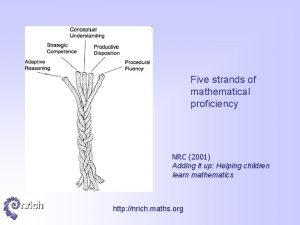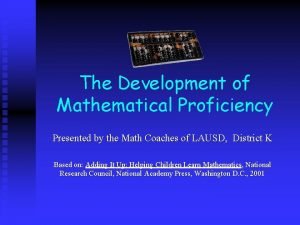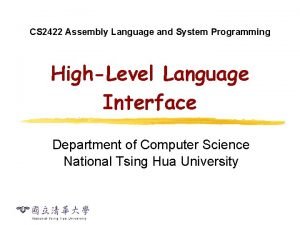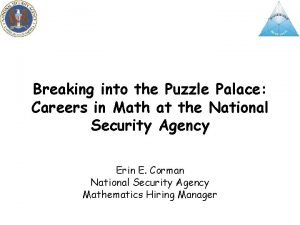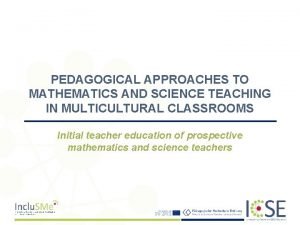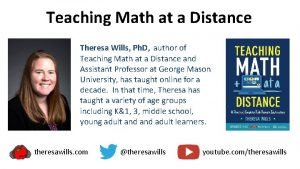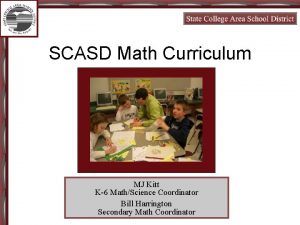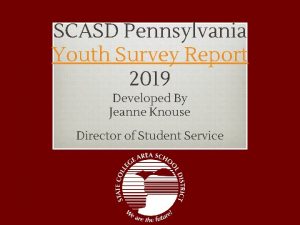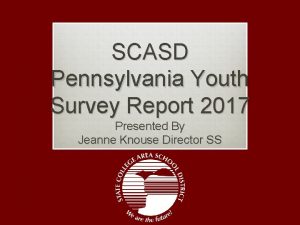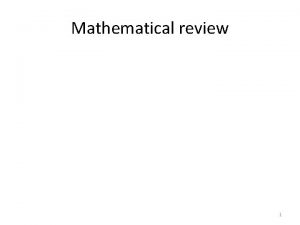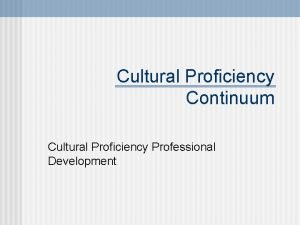Mathematical Proficiency for Teaching SCASD 7 12 Math














- Slides: 14

Mathematical Proficiency for Teaching SCASD 7 -12 Math Department Inservice 10/28/2009

Mathematical Proficiency for Teaching § Being able to help someone else know and do mathematics. § Establishing a substantial and continually growing proficiency in mathematics for oneself as a teacher. § Effectively helping one’s students develop mathematical proficiency.

Proficiencies for Teaching Math

Proficiency in the Mathematical Work of Teaching Probe mathematical ideas Access and understand the mathematical thinking of learners Know and use the curriculum Assess the mathematical knowledge of learners Reflect on the mathematical problems of practice

Proficiency in Mathematical Activity Recognize structure and conventions Connect within and outside the subject Represent Constrain and extend Generalize Model Exemplify Define Justify

Proficiency in Fostering Mathematical Goals Conceptual Understanding – connections – knowing why Procedural Fluency – flexible, efficient, accurate Strategic Competence – problem solving Adaptive Reasoning - explain & justify Productive Disposition – sees meaning – feels capable Historical and Cultural Knowledge

Situations

Situation: Division Involving 0

Focus A focus presents a particular aspect of mathematical knowledge for teaching at the secondary level that is relevant. Mathematical knowledge for teaching includes concepts, processes, representations, solution methods, interpretations, types of reasoning, properties of mathematical objects, and definitions.

Situation: What Polygons Can Be Circumscribed? In a geometry class, after a discussion about triangles, a student asked, “Can you circumscribe a circle about any polygon? ”

Misconceptions What misconceptions are likely for the foci we have just discussed?

Fostering Mathematical Goals What might teaching look like if we want to foster procedural fluency, conceptual understanding, strategic competence, adaptive reasoning, and productive disposition?

Mathematical Activities What mathematical activities might take place? Recognize structure and conventions Connect within and outside the subject Represent Constrain and extend Generalize Model Exemplify Define Justify

Proficiency in the Mathematical Work of Teaching Probe mathematical ideas - see complexity in simple ideas and reduce the complexity without destroying their integrity Access and understand the mathematical thinking of learners – see the mathematics from a learner’s perspective. Know and use the curriculum – connection; common misconceptions; multiple approaches Assess the mathematical knowledge of learners Reflect on the mathematical problems of practice – reflect on the work of teaching through a mathematical lens.
 5 strands of mathematical proficiency
5 strands of mathematical proficiency Mathematical proficiency
Mathematical proficiency Repne scasd
Repne scasd Nsa mathematics proficiency test practice test
Nsa mathematics proficiency test practice test Non mathematical economics
Non mathematical economics Definition of microteaching
Definition of microteaching Pedagogical approaches to teaching math
Pedagogical approaches to teaching math Theresa wills templates
Theresa wills templates Rita perspektiv
Rita perspektiv Ministerstyre för och nackdelar
Ministerstyre för och nackdelar Sju principer för tillitsbaserad styrning
Sju principer för tillitsbaserad styrning Vem räknas som jude
Vem räknas som jude Tack för att ni lyssnade bild
Tack för att ni lyssnade bild Claes martinsson
Claes martinsson Skriva i bunden form
Skriva i bunden form
